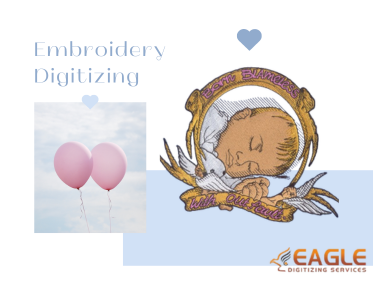What’s The Importance Of Thread Color Selection In Embroidery Digitization?
Why Color Matters: First
Impressions and Beyond
Color isn't just a visual treat; it's a language. It speaks to our emotions, communicates messages, and leaves lasting impressions. The first glance at a design often determines its impact, making color choices critical. Whether it's the vibrant hue of a brand logo or the soothing tones of home decor, the colors you choose set the stage for perception and reception. Read Here are Some Things That You Should Know When It Comes To Embroidery Digitizing!
The
Science Behind Color in Digitization
Colors are more than what meets the eye; they're a blend of science and art. The process of digitizing colors involves converting them from physical shades to digital representations. This transformation requires understanding wavelengths, light absorption, and reflection, ensuring that the colors in your design look consistent across different devices and mediums.
Color
Theory Basics: A Quick Refresher
Let's brush up on the essentials. Color theory is the framework that guides the use of color in design. The color wheel, primary and secondary colors, complementary and analogous hues—all these elements help create harmonious and striking designs. Knowing how to mix and match can elevate your digitized creations from mundane to magnificent.
The
Psychology of Color: How Hues Influence Perception
Colors are powerful influencers of human emotions and behaviors. Warm colors like reds and yellows evoke energy and warmth, while cool colors like blues and greens promote calm and serenity. Understanding the psychological impact of different hues can help you tailor your designs to elicit desired responses from your audience.
RGB
vs CMYK: Choosing the Right Color Model
When it comes to digital design, selecting the right color model is crucial. RGB (Red, Green, Blue) is ideal for digital screens, while CMYK (Cyan, Magenta, Yellow, Key/Black) is used for printing. Each model has its own gamut or range of colors, and understanding these can help ensure your designs look their best whether displayed on a screen or printed on fabric.
Thread
Color Selection: The Art and Technique
Choosing thread colors is an art that requires a keen eye and a steady hand. It's not just about picking shades that look good together; it's about finding colors that enhance the design, complement the fabric, and convey the intended message. This intricate process involves considering the thread's texture, sheen, and how it interacts with light.
Matching
Colors to Your Design: The Starting Point
Before you dive into digitization, start with a solid foundation. Matching thread colors to your design is the first step. Analyze your design’s palette, considering both dominant and subtle shades. This meticulous selection process ensures that the final embroidered piece stays true to your original vision.
The
Magic of Contrast: Making Your Design Pop
Contrast is a powerful tool in design. By pairing light and dark colors, or complementary hues, you can create eye-catching and dynamic compositions. The right contrast not only makes your design stand out but also adds depth and dimension, turning a flat image into a captivating masterpiece.
Harmony
and Balance: Achieving the Perfect Blend
While contrast is crucial, so is balance. A harmonious color palette ensures that no single color overwhelms the others. Striking the right balance involves blending hues that work well together, creating a cohesive and visually pleasing design that feels complete and well-thought-out.
Practical
Tips for Choosing Thread Colors
When it comes to selecting thread colors, practicality is key. Opt for high-quality threads that match your color specifications. Test colors in different lighting conditions to ensure accuracy. Keep a color chart handy for quick reference, and don’t hesitate to experiment with different shades to find the perfect match.
Sampling
and Testing: The Importance of Swatches
Before committing to a full design, always create swatches. Sampling allows you to see how colors interact with your chosen fabric and under various lighting conditions. This step is crucial to avoid costly mistakes and to make adjustments before the final production.
Tools
of the Trade: Digital Color Selection Software
Digital tools can simplify the color selection process. Software like Adobe Illustrator or specialized embroidery design programs offer precise color matching and visualization. These tools allow you to preview how your chosen colors will look in the final design, ensuring accuracy and saving time.
Expert
Tips: Advice from Professional Digitizers
Seasoned digitizers have a wealth of knowledge. They recommend focusing on color consistency, understanding the fabric’s influence on thread appearance, and staying updated with industry trends. Their insights can help you avoid common pitfalls and achieve professional-quality results.
Common
Mistakes and How to Avoid Them
Avoiding common mistakes is essential for successful digitization. Overcomplicating your palette, neglecting fabric color, and failing to test your design are frequent errors. Keeping your design simple, considering the fabric as part of the design, and thorough testing can prevent these issues.
Color
Clashes: Recognizing and Fixing Them
Color clashes occur when hues don’t complement each other, creating visual discord. To fix clashes, refer to the color wheel and choose harmonious combinations. Sometimes, adjusting the shade or intensity of a color can resolve the issue, leading to a more cohesive design.
Overcomplicating
Your Palette: Keep It Simple
Simplicity is often the key to elegance. Overcomplicating your color palette can lead to confusion and detract from the design’s impact. Stick to a few well-chosen colors that complement each other and convey your message effectively.
Ignoring
Fabric Color: The Canvas Matters Too
The fabric is your canvas, and its color can significantly influence the final look of your design. Always consider the fabric’s hue and how it interacts with your thread colors. This consideration ensures that the threads stand out and your design remains vibrant and clear.
Impact
on Different Types of Digitized Designs
Different designs require different color strategies. Logos demand bold, clear colors for brand recognition, while fashion designs might favor trending hues or timeless classics. Home decor designs benefit from colors that set the right mood, matching the ambiance of the space they adorn.
Logo
Embroidery: Branding Through Color
In logo embroidery, color is a critical element of brand identity. Choosing the right colors ensures that the logo is instantly recognizable and consistent with the brand’s image. This consistency helps in building brand loyalty and recognition.
Fashion
Design: Trends and Timeless Choices
Fashion is ever-evolving, but some color choices remain timeless. Staying updated with current trends while understanding the classics can help you create designs that are both contemporary and enduring. This balance ensures your work remains relevant and appealing.
Home
Decor: Setting the Mood with Thread
Home decor designs benefit greatly from thoughtful color choices. Colors set the mood of a room, creating environments that are cozy, vibrant, or serene. Selecting the right thread colors can transform ordinary items into striking decor pieces that enhance the overall aesthetic of a space.
The
Role of Light and Environment
Light and environment play a pivotal role in how colors are perceived. The same thread can look different under natural versus artificial light. Understanding these variations helps in making informed color choices that ensure your design looks great in any setting.
Lighting
Conditions: Natural vs Artificial Light
Natural light brings out the true colors of your threads, while artificial light can alter their appearance. Testing your design in both lighting conditions can help you make adjustments to ensure the colors remain consistent and true to your vision.
Context
Matters: Where Will Your Design Be Seen?
Consider the context in which your design will be seen. A design for a brightly lit retail space might require different color choices than one intended for a dimly lit home environment. Tailoring your colors to the specific context ensures your design achieves its intended effect.
Case
Studies: Success Stories and Lessons
Learned
Real-world examples offer valuable insights. Here are some case studies that highlight the impact of thoughtful color choices in digitized designs.
Advanced
Techniques for Color Mastery
For those looking to push the boundaries, advanced techniques offer new possibilities.
Gradient
Effects: Blending Colors Seamlessly
Creating gradient effects with threads involves blending colors smoothly, resulting in a dynamic and visually appealing design. This technique can add depth and complexity, making your embroidery stand out.
Metallic
and Neon Threads: Adding Some Sparkle
Metallic and neon threads can add a touch of glamour and modernity to your designs. These threads catch the light beautifully, adding an extra dimension that’s perfect for making a statement.
Custom
Dyeing: When Off-the-Shelf Isn't Enough
Sometimes, the perfect color isn’t available off the shelf. Custom dyeing threads allow for complete control over your palette, ensuring that every hue is exactly as you envisioned.
Sustainability
and Ethical Considerations
In today’s world, sustainability and ethics are more important than ever.
Eco-Friendly
Thread Choices: Going Green
Choosing eco-friendly threads made from sustainable materials can reduce your environmental impact. These threads are often just as durable and vibrant as their traditional counterparts, making them a smart choice for the conscious designer.
Ethical
Sourcing: Know Your Suppliers
Ensuring that your threads are ethically sourced means verifying that suppliers adhere to fair labor practices and environmental standards. This diligence supports ethical production and contributes to a fairer industry.
In conclusion, the importance of thread color selection in embroidery digitization cannot be overstated. Color is not merely a visual element but a
powerful language that communicates emotions, messages, and impressions.
Understanding the science behind color, the basics of color theory, and the psychology
of hues is essential for creating impactful designs. Choosing the right color
model, considering thread texture and sheen, and achieving harmony and balance
in color palettes are crucial steps in the digitization process. Practical
tips, expert advice, and awareness of common mistakes further enhance the
quality of digitized designs. Moreover, recognizing the influence of light,
environment, and fabric color, along with embracing advanced techniques and
ethical considerations, contribute to creating designs that are not only
visually appealing but also sustainable and ethically produced. In essence,
thread color selection is both an art and a science that elevates digitized
designs to new heights of creativity and effectiveness.



